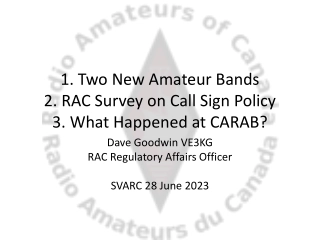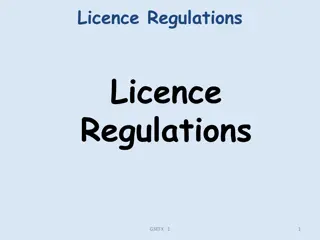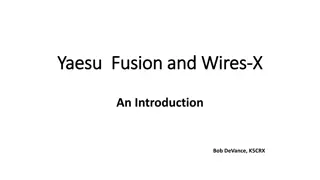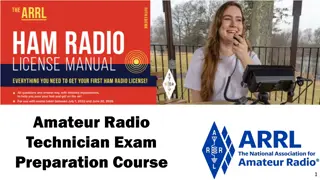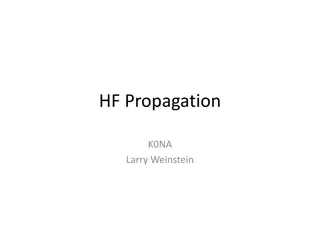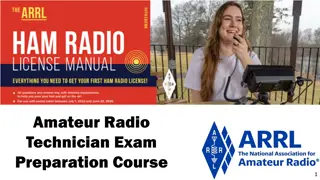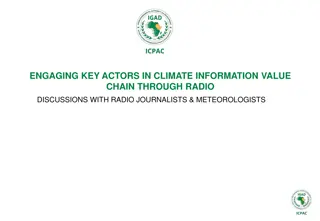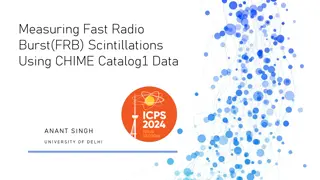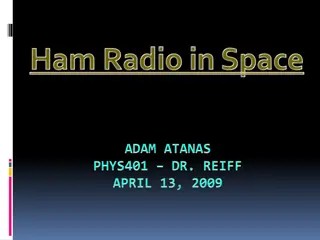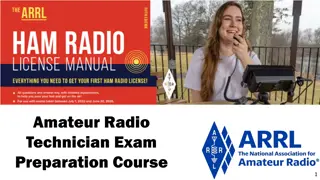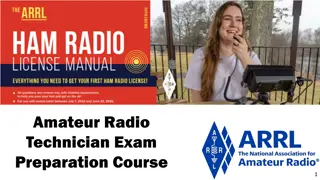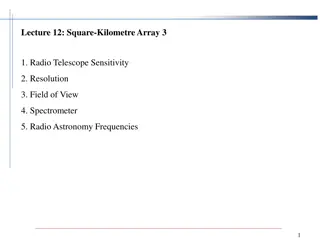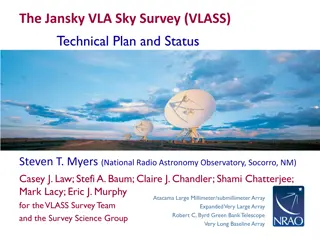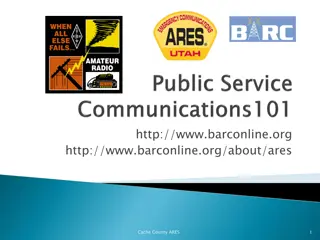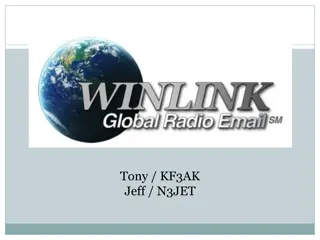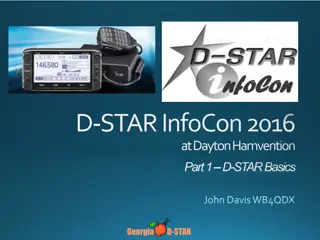Effective Communication Practices in Amateur Radio Operating
Learn about essential communication practices in amateur radio operation, including listening before calling, making CQ calls, frequency changes, replying to calls, split frequency usage, and participating in contests. These practices ensure efficient and effective communication among amateur radio enthusiasts, helping to establish connections and exchange information smoothly.
Download Presentation

Please find below an Image/Link to download the presentation.
The content on the website is provided AS IS for your information and personal use only. It may not be sold, licensed, or shared on other websites without obtaining consent from the author. Download presentation by click this link. If you encounter any issues during the download, it is possible that the publisher has removed the file from their server.
E N D
Presentation Transcript
Operating Operating G3EFX 2 1
OPERATING Always listen before calling and ask if the frequency is in use. (a local station may be in contact with a distant station which you cannot hear) G3EFX 1D1 2
CQ Calls A CQ call is a general call to any amateur who may be listening. It is an invitation to start a conversation. G3EFX 2A2 3
CQ Calls (VHF FM) Use short call e.g. CQ CQ CQ from M0ABC Mike Zero Alpha Bravo Charlie Repeat only after a reasonable pause. (30 seconds ?) G3EFX 2A2 4
CQ Calls (SSB) Use longer call to allow receiving station to tune in e.g. CQ CQ CQ from M0ABC CQ Mike Zero Alpha Bravo Charlie Sent three or four times. Short pauses (3 seconds) between transmissions are acceptable. G3EFX 2A2 5
Change Frequency - 1 If calling CQ on a calling channel (e.g. 145.500 MHz) you must change frequency as soon as contact is established. Calling channels should be kept clear at all other times. G3EFX 2A2 6
Change Frequency - 2 An alternative to a specific calling frequency, some channels are specified as centres of activity . e.g. 144.300 MHz is the allocated centre of activity for SSB voice. You can expect to find SSB signals from approximately 144.265 to 144.335 MHz. G3EFX 2A2 7
Reply to CQ call If replying to a CQ call it is usual practice to reply on the same frequency. G3EFX 2A2 8
Split Frequency Sometimes, if a lot of people reply to a CQ call, the CQ station will say listening five up meaning listening 5 kHz up. This is called split frequency which helps spread out the signals. G3EFX 2A1 9
Contests - 1 Contests are very popular and are sometimes referred to as Sport Radio . Contests usually require an exchange of information e.g. signal report, serial number and location. G3EFX 2A4 10
Contests - 2 Contests often have sections for different bands, power levels, modes. G3EFX 2A4 11
Contests - 3 Contests can run from as little as two hours to two days. Points can be awarded for: number of contacts countries/continents distances G3EFX 2A4 12
Awards Achievement awards are available for working: Continents, countries, islands, prefixes and locator squares. Variations may include frequency bands or low power. G3EFX 2A4 13
Logs & Records - 1 A record of transmissions and stations worked can be useful to: check for transmission times in case of an interference issue keep a list of callsigns, names and locations compare signal quality against previous contacts G3EFX 2A6 14
Logs & Records - 2 An individual log should contain: Date, time (UTC), callsign of station worked, mode, frequency, power output G3EFX 2A6 15
Spectrum Abuse - 1 Transmission of music and the use of offensive or threatening language are unacceptable in amateur radio. G3EFX 2A7 16
Spectrum Abuse - 2 The response to unacceptable behaviour is simple IGNORE IT G3EFX 2A7 17
Spectrum Abuse - 3 Licence Clause 11(2): you shall only talk to other radio amateurs If you talk to anyone who does not give a callsign, you are committing a criminal offence ! You could be fined, lose your licence and equipment and get a criminal record! G3EFX 1C1 18
Band Plans G3EFX 2B
Band Plans - 1 WHY? Transmission modes - Voice (Single Sideband) - Voice (Frequency Modulation) - Morse code - Data etc do not mix well so separate sub-bands are allocated G3EFX 2B 20
Band Plans - 2 The International Amateur Radio Union (IARU) produce the band plans and the RSGB publish 24 band plans for the UK. You only need to know about TWO for the exam: 14 MHz (twenty metres) 144 MHz (two metres) (Both plans given in exam) G3EFX 2B1 21
Band Plan 144 MHz G3EFX 2B1 22
Band Plan 14 MHz G3EFX 2B1 23
Band Plans Notes - 1 1. Narrow band modes eg CW (Morse code) and data tend to be at the lower end of the bands. 2. Lower sideband (LSB) is normally used below 10 MHz and Upper sideband (USB) above 10 MHz. One important exception is that you MUST use USB in the 5 MHz band (the frequencies are shared with the UK military and the military only use USB). G3EFX 2B1 24
Band Plans Notes - 2 Note that band plans in other countries and IARU regions may not align with the UK band plans e.g. the UK (IARU Region 1) 40 metre band extends from 7.0 to 7.2 MHz but in the USA (IARU Region 2), the band is 7.0 to 7.3 MHz and hence America has a different band plan. G3EFX 2B1 25
Band Plans Notes - 3 3. Transmission on beacon frequencies must be avoided. 4. SSB (voice) operation should not be used on the 10 MHz (30 metre band) because it is only 50 kHz wide. G3EFX 2B1 26
Band Plans Notes - 4 5. Contests shall NOT be organised in the 5 MHz, 10 MHz, 18 MHz and 24 MHz bands. 6. Transmissions on satellite frequencies should be avoided for terrestrial contacts. G3EFX 2B1 27
Band Plans Notes 5 The RF spectrum is allocated to many other users. Even some amateur bands are shared with other organisations eg our seventy centimetre band (430-440 MHz) is shared with the Ministry of Defence. G3EFX 2B1 28
Band Plans Other Users A portion of the VHF spectrum G3EFX 2B1 29
Codes & Abbreviations G3EFX 2A
Phonetic Alphabet A-N A C E G I K M Alpha Charlie Echo Golf India Kilo Mike B D F H J L N Bravo Delta Foxtrot Hotel Juliet Lima November G3EFX 2A3 31
Phonetic Alphabet O-Z O Q S U W Y Oscar Quebec Sierra Uniform Whisky Yankee P R T V X Z Papa Romeo Tango Victor X-ray Zulu Learn & remember !! G3EFX 2A3 32
WHY Q codes - 1 Original use was to speed up Morse Code contacts. Morse is quite slow usually < 20 wpm (speech is at least 200 words per minute). Q codes are often used in voice contacts because they are international. G3EFX 2A5 33
WHY Q codes - 2 For Example - QTH means location in English emplacement in French el lugar in Spanish G3EFX 2A5 34
Q codes Memorise the following ten codes: QRM QRP QRZ QSL QSY QRN QRT QSB QSO QTH G3EFX 2A5 35
Q codes - 1 QRM Interference from other stations (think M = Man-made) QRN Interference from static eg thunder storms (think N = Natural) G3EFX 2A5 36
Q codes - 2 QRP Low Power (e.g. 5 Watts) QRT Closing down QRZ Who is calling? QSB Fading (Signals varying in strength) G3EFX 2A5 37
Q codes - 3 QSL Confirmation QSO Contact (i.e. conversation with a station) QSY Change frequency QTH Location G3EFX 2A5 38
Abbreviations Memorise the following: CQ - general call CW - Morse code (Continuous or Carrier Wave) DE - from DX - long distance R - Received (hence ROGER from old phonetic alphabet) RST - Readability, Signal Strength & Tone report SIG - Signal UR - Your WX - Weather Why?? Quicker Morse code and Internationally recognised G3EFX 2A5 39
RST Reports Readability 1 to 5 Strength 1 to 9 Tone 1 to 9 The higher the figure, the better the signal G3EFX 2A5 40
Readability code 1 - unreadable 2 - barely readable 3 - readable with difficulty 4 - readable with a little difficulty 5 - totally readable Note only FIVE levels G3EFX 2A5 41
Signal Strength code 1 - faint, barely perceptible 2 - very weak 3 - weak 4 - fair 5 - fairly good 6 - good 7 - moderately strong 8 - strong 9 - very strong NINE levels G3EFX 2A5 42
Tone code Only used for CW (Morse) and other digital modes eg RTTY 1 - extremely rough note 2 - very rough note 3 - rough note 4 - fairly rough note 5 - note modulated with strong ripple 6 - modulated note 7 - near DC note with small ripple 8 - good note with trace of ripple 9 - pure note NINE levels G3EFX 2A5 43
RS Examples 5 & 9 Totally readable & very strong 3 & 7 Readable with difficulty and moderately strong 2 & 3 Barely readable and weak 1 & 9 Unreadable but very strong (microphone fault ?) G3EFX 2A5 44
RST Examples 599 Totally readable very strong pure note 333 Readable with difficulty weak signal rough note G3EFX 2A5 45
Common Modes CW Morse code - can get through when other modes e.g. SSB, fail SSB best for HF phone operation FM - easiest to tune in and listen to (rarely used below 28 MHz) G3EFX 2E 46
Some Other Modes PSK & RTTY common digital modes FT8 weak signal digital mode FSTV full definition television (> 1240 MHz) SSTV slow scan television (HF & VHF) G3EFX 2E 47
Computers Many modes e.g. RTTY, PSK, SSTV, CW (morse code) can be sent and received using a personal computer connected to the transceiver. G3EFX 2E2 48
Callsign directories RSGB year book & CD (Europe) www.qrz.com (worldwide) G3EFX 49
Country prefixes Memorise the following: EI Ireland I Italy VE Canada VK Australia ZL New Zealand F France JA Japan PA Netherlands W USA G3EFX 2A3 50


